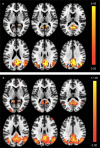APOE4 moderates effects of cortical iron on synchronized default mode network activity in cognitively healthy old-aged adults
- PMID: 32211498
- PMCID: PMC7085281
- DOI: 10.1002/dad2.12002
APOE4 moderates effects of cortical iron on synchronized default mode network activity in cognitively healthy old-aged adults
Abstract
Introduction: Apolipoprotein E ε4 (APOE4)-related genetic risk for sporadic Alzheimer's disease is associated with an early impairment of cognitive brain networks. The current study determines relationships between APOE4 carrier status, cortical iron, and cortical network-functionality.
Methods: Sixty-nine cognitively healthy old-aged individuals (mean age [SD] 66.1 [± 7.2] years; Mini-Mental State Exam [MMSE] 29.3 ± 1.1) were genotyped for APOE4 carrier-status and received 3 Tesla magnetic resonance imaging (MRI) for blood oxygen level-dependent functional magnetic resonance imaging (MRI) at rest, three-dimensional (3D)-gradient echo (six echoes) for cortical gray-matter, non-heme iron by quantitative susceptibility mapping, and 18F-flutemetamol positron emission tomography for amyloid-β.
Results: A spatial pattern consistent with the default mode network (DMN) could be identified by independent component analysis. DMN activity was enhanced in APOE4 carriers and related to cortical iron burden. APOE4 and cortical iron synergistically interacted with DMN activity. Secondary analysis revealed a positive, APOE4 associated, relationship between cortical iron and DMN connectivity.
Discussion: Our findings suggest that APOE4 moderates effects of iron on brain functionality prior to manifestation of cognitive impairment.
Keywords: APOE4; DMN; ICA; MRI; PET; QSM; fMRI; flutemetamol; gradient echo; iron; preclinical Alzheimer's disease.
© 2020 The Authors. Alzheimer's & Dementia: Diagnosis, Assessment & Disease Monitoring published by Wiley Periodicals, Inc. on behalf of the Alzheimer's Association.
Figures





References
-
- Corder EH, Saunders AM, Strittmatter WJ, et al. Gene dose of apolipoprotein E type 4 allele and the risk of Alzheimer's disease in late onset families. Science. 1993;261:921‐923. - PubMed
-
- Farrer LA, Cupples LA, Haines JL, et al. Effects of age, sex, and ethnicity on the association between apolipoprotein E genotype and Alzheimer disease. A meta‐analysis. APOE and Alzheimer Disease Meta Analysis Consortium. JAMA. 1997;278:1349‐1356. . - PubMed
-
- Deary IJ, Whiteman MC, Pattie A, et al. Cognitive change and the APOE epsilon 4 allele. Nature. 2002;418:932. - PubMed
Grants and funding
LinkOut - more resources
Full Text Sources
Miscellaneous
